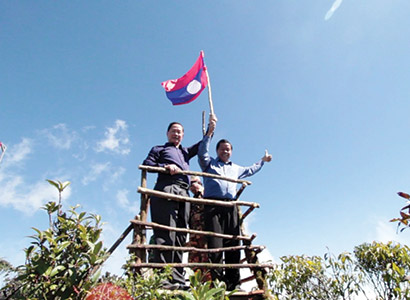 |
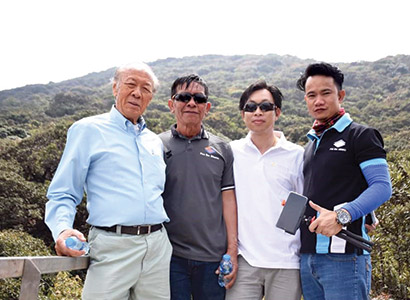 |
Mr Khamphay Somsana (right) holds Lao flag on the top of Phou Bia Mountain.
|
A group of domestic tourists experience the top of Phou Bia Mountain. |
Phou Bia, the roof of Laos, set to be new tourist attraction
Vientiane Times is publishing a series of articles in relation to Laos’ Asean Chairmanship, the Asean Tourism Forum, and Visit Laos Year, all taking place in 2024.
Phou Bia, the highest mountain in Laos at 2,820 metres, is set to become a new tourism attraction in line with the government’s policy to boost the tourism industry to cope with economic challenges.
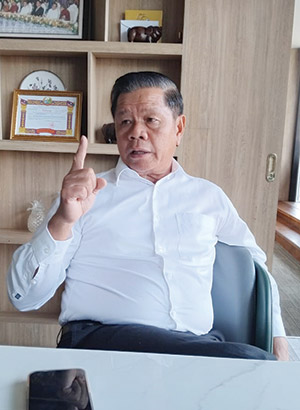 |
| Mr Khamphay Somsana. |
The President of the Khamphay Sana Group, Mr Khamphay Somsana, has been given the green light to develop new tourist facilities on Phou Bia Mountain, situated in Anouvong district, 30 km north of Xaysomboun province’s capital.
“We will finish the construction of a 51-unit resort and a concrete road to access the top of Phou Bia next year,” Mr Khamphay said.
“The completion of the resort and the road will enable domestic and foreign tourists to experience the natural environment of the highest mountain in Laos.”
Mr Khamphay planned to complete constructing the road this year but weather conditions hindered the work. He plans to accelerate the construction of the road and will finish it by the dry season of 2024.
“We completed the design of the 51-unit resort, which will be located on a mountain slope. We are clearing the land for building a restaurant and a convenience store, and arranging the space for camping tourists,” Mr Khamphay said.
In 2021, authorities allowed the Khamphay Sana Group to develop Phou Bia Mountain as a sustainable tourist site under a 99-year concession.
At that time, the company said it expected to spend US$500 million to develop tourism activities along with environmental conservation measures.
The main components of the project include hiking, zip lining, mountain climbing, cycling, camping and homestay, an amusement park, a five-star hotel, and a cable car.
“I won’t abandon the development of activities enshrined in the master plan for the Phou Bia development project, but I need some time to study the market prospects and economic returns,” Mr Khamphay said. Xaysomboun is a mountainous region and is located 230 km north of Vientiane. The annual average temperature on the top of Phou Bia is about – 5˚C.
The province has huge potential to develop tourist attractions and facilities to welcome visitors from around the world.
Several tourist sites in the region have been opened to domestic and international travellers, including San Phou Mok (Fog Mountain), Chao Anouvong Cave, and the viewpoint at Ban Phou Huaxang, where it’s possible to camp on the rocks and get a panoramic view of the town.
One of the main challenges for Xaysomboun province is inadequate infrastructure, especially poor roads linking towns to tourist sites. In addition, road access to Xaysomboun from Vientiane and other provinces remains a challenge, hindering travel to the region.
As authorities in Xaysomboun prepare to mark the 10th anniversary of its establishment as the 18th province of Laos at the end of 2024, coinciding with the Visit Laos Year 2024, a number of activities will be organised to welcome visitors.
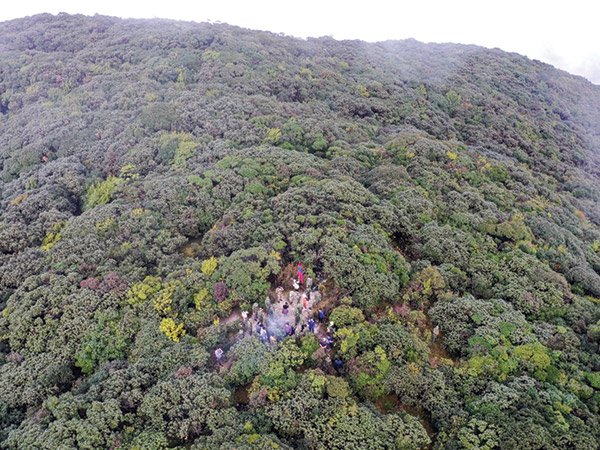 |
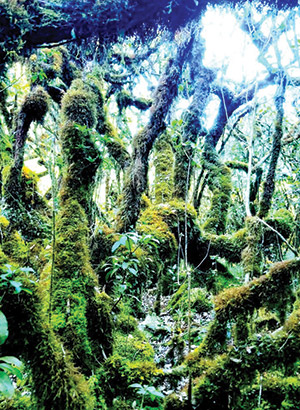 |
A view of Phou Bia, the highest mountain in Laos at 2,820 metres.
|
Phou Bia is home to a variety of rare plant and animal species. |
The provincial leadership is encouraging the private sector to improve facilities, including restaurants, hotels and tourism-related services, to welcome more visitors next year.
Mr Khamphay said “When we talk about Phu Bia Mountain, most domestic and foreign visitors, particularly hikers and adventure seekers want to come to Xaysomboun to experience the roof of Laos. However, we need to improve necessary infrastructure and tourism related facilities including restaurants, hotels and road access to welcome holiday makers.”
He added that tourism can be the main source of income for Xaysomboun if the tourism sector is properly developed.
He warned that all development projects, notably mining, need to take into account environmental issues, and the development of eco-tourism will be affected if any development project impacts forest resources.
He urged the state sector to strictly inspect development projects, and to revoke the licence of any project found to be causing damage to the environment.
“We have to choose between short-term and long-term benefits for the country. I can assure you that the income from tourism can generate sustainable revenues for the country, but the income generated from excavation of natural resources will be depleted one day,” Mr Khamphay said.
By Times Reporters
(Latest Update December 25, 2023)
|






